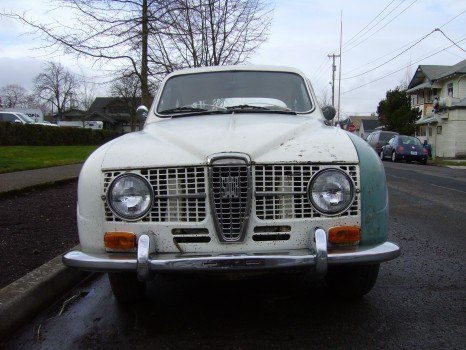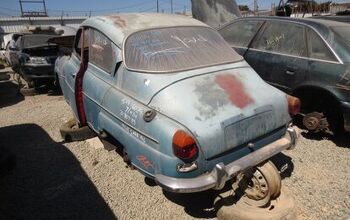Curbside Classics: 1968 Saab 96

It’s hard to look at this old Saab and not get choked up. And it’s not just because this once proud and spunky company is on the ropes. Old Saabs just have a way of stirring my emotions. This is going to be a Saab story.
The first time I encountered a Saab in Austria fifty years ago, I literally choked as an accelerating Swedish tourist engulfed me in a cloud of acrid blue exhaust from his two-stroke 93. But I was seduced (forever) by the purity of line on that svelte fastback as it gradually disappeared in its smoke screen.
Erik Carlsson’s ballsy victories in his red 96 over the big guys at Monte Carlo left me in awe. And the gutsy way a bunch of underemployed aeronautical engineers came up with the original 92 is inspirational. The vivid memories of time spent in my good friend’s identical 96 are sweet. But the “For Sale” sign on this one just makes me sad. Who could break up with a car like this? Waves of regret engulf me as I remember all the cars I sold and wish I hadn’t.
Enough emoting. Saab’s initial adoption of the two stroke engine was highly pragmatic: the tiny engine fit perfectly in front of the transaxle and its lightness engendered good handling. But original it wasn’t; the engine, drive train and the whole layout of the 92 was heavily cribbed from DKW, the mother of all zweitakter.
Two strokes engines may have been fairly common in Europe at the time, but they reeked of eccentricity stateside. Yet there were several 93s and 96s whose comings and goings I followed with interest after we moved to Iowa City in 1960. It was a university town, and Saab’s reputation as a college professor’s car was already well burnished. Curious, how did the same crowd that adopted these smoky cars as a badge of auto-intellectual superiority later become early Prius adopters? Atonement for prior sins?
In 1967, nascent environmental awareness (and the EPA) forced Saab to finally abandon the stinky two-stroke. Finding a suitable four-stroke to fit in the six-pack sized space where the little popcorn-popper had long resided was no small challenge. As luck would have it, Ford in Germany had an ultra-compact 60 degree V4; a Cologne V6 minus two cylinders. Forty years after this Saab’s V4 first coughed to life, Mustang and Explorer Cologne V6s are still rolling off that same transfer line. Think Ford has amortized this design by now?
Whereas a 60 degree V6 has a fairly high degree of harmonic and firing balance, cutting off two cylinders makes a V4 sound and feel exactly like . . . a V6 with two dead cylinders. A rougher and less even-firing engine would be hard to invent. Ironic too, considering how exceptionally smooth the little two-stroke had been. There was a good reason DKW and Auto-Union used the 3=6 slogan for their 3 cylinder two-strokes: they had the same number of power impulses and the smooth running characteristics of an inline six.
Nevertheless, the lumpy V4 was a good fit in the 96. And, unlike the two-stroke, it had a lusty torque curve, good mileage, a clean exhaust, and kept the Saab eccentricity quotient intact. Now I’ve always thought that the NSU or Mazda rotary would have been the perfect successor. It would have been a glove fit, and a rotary’s smooth running and off-throttle popping sounds almost like a two-stroke. There’s got to be one out there somewhere.
As Saab slides into its final coma, it’s both sad and amusing to hear of the heroic calls for its resuscitation (I’ve kept the emotions at bay long enough). Saab was a tiny European car maker, which along with so many others of its size, was long overdue to slip into the annals of history. Saab only created two unique platforms in its entire sixty year history: the 92 (93 & 96), and its replacement, the 99 (900) of 1969. It never once designed an original engine. And everything since the 900 was begged or borrowed: platforms from Fiat (9000), Lancia (600), and GM. Forget “Born from Jets”; try “Born from obsolete GM platforms.”
GM’s purchase of Saab was phenomenally stupid. There was nothing to suggest that they could bring lasting health and success to this then already moribund and broke marque. History has been harsh to smaller premium brands and the “rescue” of such (NSU by VW and Rover by BMW) were abject failures. Lancia is on perpetual life support by mother Fiat. But GM’s hubris was limitless, and there’s a sucker born every minute. Speaking of which, can I interest you in a well-used, slightly rusty 1968 Saab 96? It’s only $850, and I’m sure it’s got lots of life in it yet. Unlike its maker.

More by Paul Niedermeyer
Latest Car Reviews
Read moreLatest Product Reviews
Read moreRecent Comments
- ToolGuy "Note that those vehicles are in direct competition with models Rivian sells"• I predict that we are about to hear why this statement may not be exactly true
- ToolGuy From the relevant Haynes Repair Manual:"Caution: The 4.6L models require a special tool to extract the water pump from the coolant crossover housing. This special tool is expensive and the removal procedure is difficult. Have the water pump replaced by a dealer service department or other qualified automotive repair facility if the tool is not available."One version of the tool is Lisle 14440; I paid $10.82 (less 5% discount, plus shipping).You can see why I never attempt my own maintenance or repairs. 😉
- Dave M. IMO this was the last of the solidly built MBs. Yes, they had the environmentally friendly disintegrating wiring harness, but besides that the mechanicals are pretty solid. I just bought my "forever" car (last new daily driver that'll ease me into retirement), but a 2015-16 E Class sedan is on my bucket list for future purchase. Beautiful design....
- Rochester After years of self-driving being in the news, I still don't understand the psychology behind it. Not only don't I want this, but I find the idea absurd.
- Douglas This timeframe of Mercedes has the self-disintegrating engine wiring harness. Not just the W124, but all of them from the early 90's. Only way to properly fix it is to replace it, which I understand to be difficult to find a new one/do it/pay for. Maybe others have actual experience with doing so and can give better hope. On top of that, it's a NH car with "a little bit of rust", which means to about anyone else in the USA it is probably the rustiest W124 they have ever seen. This is probably a $3000 car on a good day.






































Comments
Join the conversation
These Saabs were great, I always regretted not aqcuiring one. Hard to find a good one now. This one is kind of shabby looking: it doesn't show off the beautifully unique design; its crying out for a makeover.
I swear I think I saw this car last weekend, north of Chicago. I'm serious, I'd be happy to tell you all about the thrilling encounter, and I even took a photo. (Unless they all had green driver's-side front fenders, that is.)